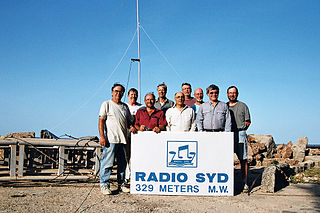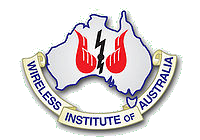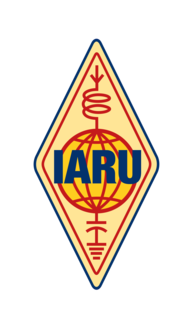
A DX-pedition is an expedition to what is considered an exotic place by amateur radio operators and DX listeners, perhaps because of its remoteness, access restrictions or simply because there are very few radio amateurs active from that place. This could be an island, a country, or even a particular spot on a geographical grid. "DX" is a telegraphic shorthand for "distance" or "distant".

The Wireless Institute of Australia (WIA) was formed in 1910, and is the first and oldest national amateur radio society in the world. It represents the amateur radio operators of Australia as the AR "peak body" in dealings with the Australian Communications and Media Authority (ACMA), the authority under the government of Australia that administers communications within and external to Australia. The WIA publishes a bi-monthly journal for its membership called Amateur Radio. The organisation is the national society representing Australia in the International Amateur Radio Union.

The International Amateur Radio Union (IARU) is an international confederation of national organisations that allows a forum for common matters of concern to amateur radio operators worldwide, and collectively represents matters to the International Telecommunication Union (ITU). The International Amateur Radio Union was founded in 1925 and, as of November 2019, it is composed of 172 national member societies.

Amateur radio international reciprocal operating agreements permit amateur radio operators (hams) from one country to operate a station whilst traveling in another without the need to obtain additional licenses or permits.

In times of crisis and natural disasters, amateur radio is often used as a means of emergency communication when wireline, cell phones and other conventional means of communications fail.
The New Zealand Association of Radio Transmitters (NZART) is a non-profit organisation of amateur radio enthusiasts in New Zealand. It represents New Zealand amateur radio operators nationally and internationally. NZART is a founding member of the International Amateur Radio Union. It is an association of individual members, however those members are encouraged to form local branches.
Call signs in India are unique identifiers for telecommunications and broadcasting in India. The Ministry of Communications and Information Technology regulates call signs nationally, and the International Telecommunication Union regulates call signs internationally.
Amateur radio or ham radio is practised by more than 42,000 licensed users in India. The first amateur radio operator was licensed in 1921, and by the mid-1930s, there were around 20 amateur radio operators in India. Amateur radio operators played an important part in the Indian independence movement with the establishment of illegal pro-independence radio stations in the 1940s. The three decades after India's independence saw only slow growth in the numbers of operators until the then Prime Minister of India and amateur radio operator, Rajiv Gandhi (VU2RG), waived the import duty on wireless equipment in 1984. Since then, numbers have picked up, and as of 2007, there were more than 16,000 operators in the country. Amateur radio operators have played a vital role during disasters and national emergencies such as earthquakes, tsunamis, cyclones, floods, and bomb blasts, by providing voluntary emergency communications in the affected areas.
The Irish Radio Transmitters Society (IRTS) is a national non-profit organization for amateur radio enthusiasts in Ireland. Key missions of the IRTS include promoting amateur radio experimentation and representing the interests of Irish amateur radio operators before Irish and international telecommunications regulatory authorities. In particular, since 2005 in agreement with Communications Regulator (Comreg), the IRTS supports the entire examination process for the Experimenter's Licence including setting, organising, and correcting examinations for the Irish amateur radio license. The organization has no paid employees, and all tasks are performed by volunteers. IRTS is the national member society representing Ireland in the International Amateur Radio Union.

Amateur radio, also known as ham radio, is the use of radio frequency spectrum for purposes of non-commercial exchange of messages, wireless experimentation, self-training, private recreation, radiosport, contesting, and emergency communication. The term "amateur" is used to specify "a duly authorised person interested in radioelectric practice with a purely personal aim and without pecuniary interest;" and to differentiate it from commercial broadcasting, public safety, or professional two-way radio services.
The Cambridge University Wireless Society (CUWS) is the amateur radio club of the University of Cambridge, England.
Call signs in the Middle East are unique identifiers for telecommunications and broadcasting in the Middle East. Call signs are regulated internationally by the International Telecommunication Union (ITU) and nationally by local government and international agencies in Israel, Jordan, Lebanon, Syria, The Palestinian Authority, occupied territories and other nations or DXCC entities.
Amateur radio call signs are allocated to amateur radio operators around the world. The call signs are used to legally identify the station or operator, with some countries requiring the station call sign to always be used and others allowing the operator call sign instead.
Call signs in Korea are unique identifiers for telecommunications and broadcasting on the Korean peninsula. Call signs are regulated internationally by the ITU as well as nationally in South Korea by the Korea Communications Commission in the Ministry of Information and Communication. Not much is known outside of North Korea how amateur radio is regulated, although a foreign amateur was asked to appear before the "Radio Regulation Board" in 2002. Also, North Korea's Cultural Relations with Foreign Countries recently issued an operating permit, which was countermanded by the Ministry of Telecommunications and Posts.

The Luxembourg Amateur Radio Union (LARU) is a national non-profit organization for amateur radio enthusiasts in Luxembourg . The LARU was founded on January 1, 2014. The LARU promotes technical progress and cohesion of amateur radio operators. The LARU sets priorities in emergency communications, digital voice communications, digital data transmission, science and education.
Call signs in Asia are rarely used to identify broadcast stations. In most Asian countries, broadcast stations use other forms of identification. Japan, South Korea, Indonesia, the Philippines and Taiwan are exceptions to this rule. Amateur radio stations in India, Pakistan, Korea and Japan are allocated call-signs.
Call signs in Europe are codes consisting of a three letter country code and a series of letters and numbers, used as unique identifiers for broadcasting and telecommunications. These are not designated formally to all broadcast stations in Europe like they are in other parts of the world, but some broadcasters have developed their own makeshift call signs. It is quite common that instead of regular call signs abbreviations of the stations' names are used. In most of Europe, TV and radio stations have unique names, such as ProSieben in Germany, France 2 in France, Nova Television in Bulgaria, Antena 3 in Spain, etc.
Call signs in Antarctica include a three letter region code and a series of numbers and letters.
Call signs in United Kingdom include a three letter country code, and a series of letters and numbers.
Mount Abu HAM Radio Club (MHRC) is a non-profit organization for amateur radio operators all over the world. The club was established on 17 October 2013 at Mount Abu with ‘One World, One Family, One Communications’ as its objective and has been registered under Indian Societies Registration Act of 1860. MHRC has more than 200 active HAMs as its members and is also a member of various international HAM clubs such as ARSI Amateur Radio Society of India, EURAO European Radio Amateurs' Organization.







